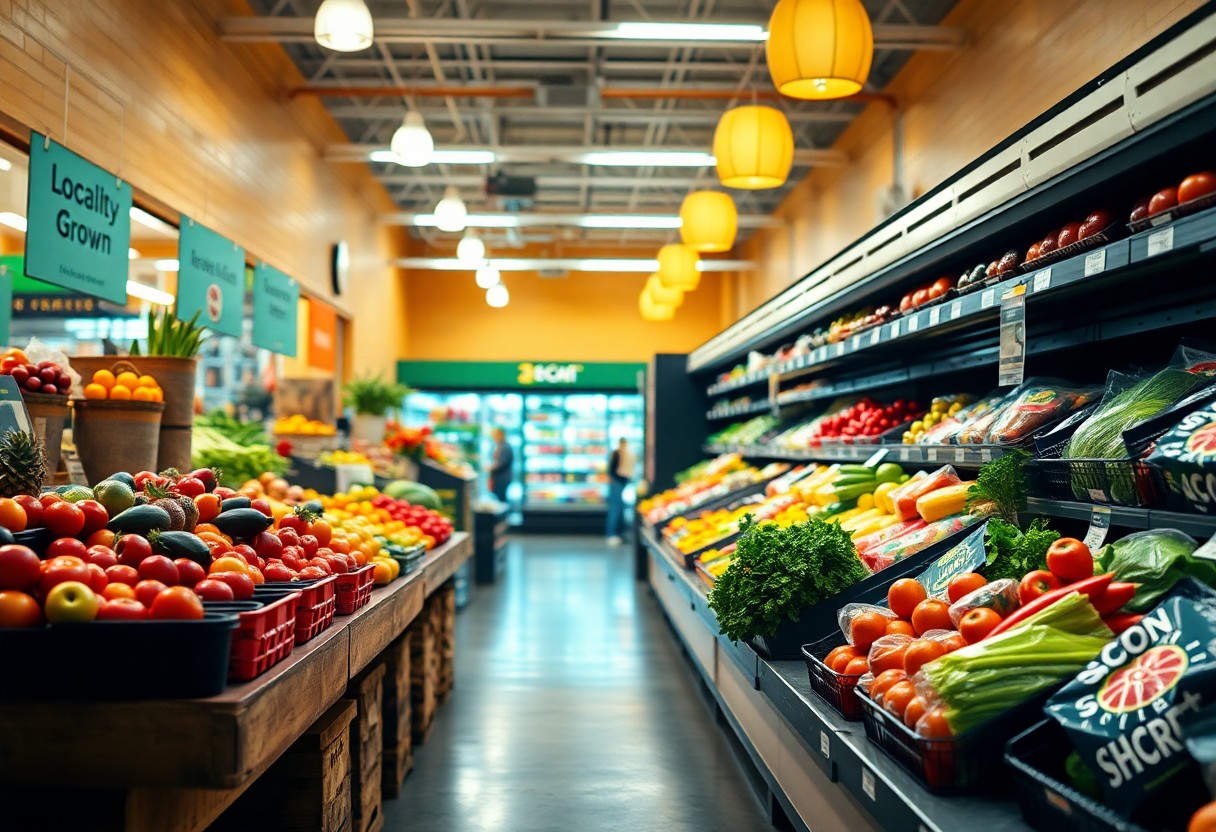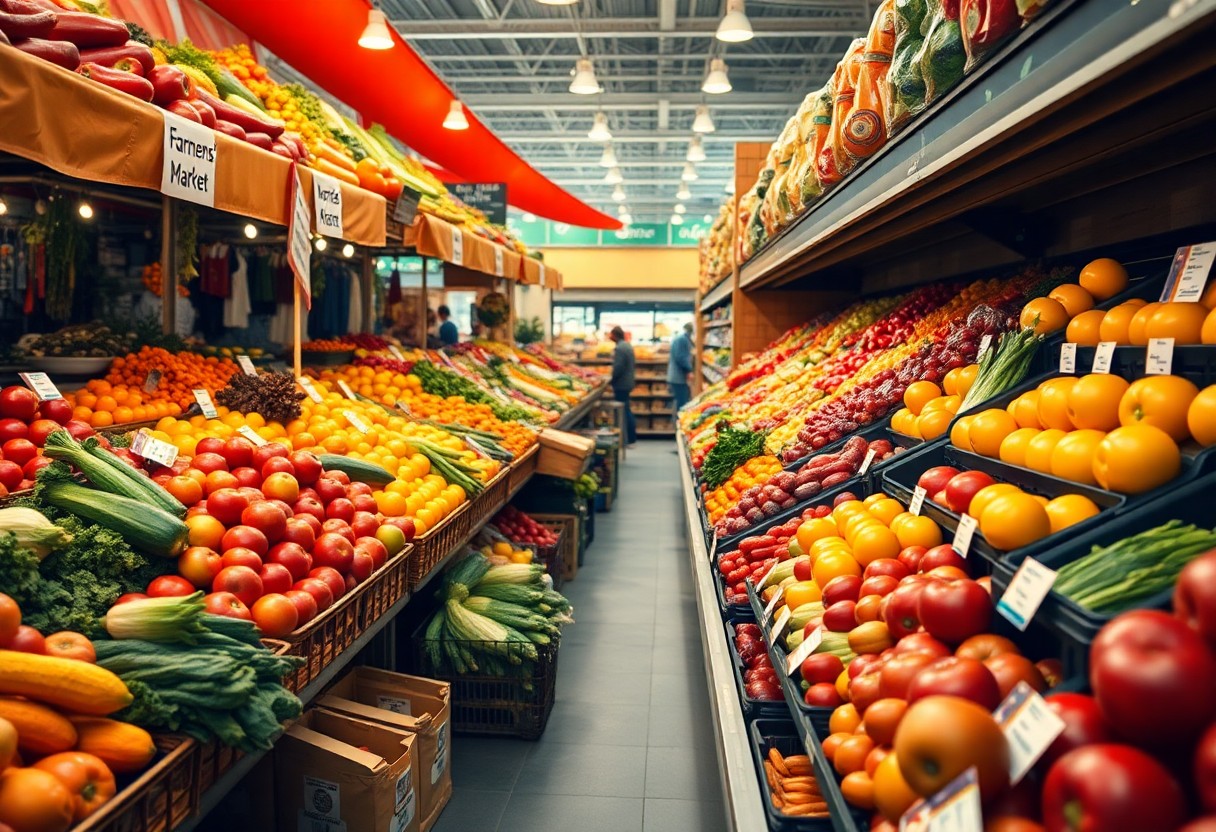It’s vital to know where to find the freshest and highest quality fruits and vegetables to ensure your meals are both nutritious and delicious. When comparing local markets to supermarkets, you’re likely to discover that local produce often boasts superior flavor and freshness due to shorter transport times and sustainable practices. However, supermarkets may provide convenience and variety that can be appealing. In this post, you’ll learn how to make an informed choice about where to source your produce for the best culinary experience.

The Importance of Fresh Produce
Fresh produce plays a vital role in your overall health and well-being. Accessing quality fruits and vegetables not only boosts your immune system but also enhances your mood and energy levels. The difference between Farm Fresh vs. Store Bought-What’s the Difference? can impact your health significantly, making it necessary to prioritize where you shop for produce.
Nutritional Benefits
Consuming fresh produce provides a higher concentration of necessary vitamins, minerals, and antioxidants compared to store-bought options. Nutrient levels in fruits and vegetables can decline rapidly over time, and when you choose local sources, you maximize your intake of these vital nutrients, promoting better health and vitality.
Taste and Quality
The flavor of fresh produce is often unmatched, with local fruits and vegetables boasting superior taste due to their shorter time from harvest to plate. This freshness contributes to a vibrant, fuller flavor profile, making meals more enjoyable. Local options often come from small farms where the focus is on quality, allowing you to savor the true essence of what you eat.
Fruits and vegetables harvested at peak ripeness have a complex flavor that is often lost in supermarket options, which may be picked early for transport. You may find that a ripe tomato from a local farmer’s market bursts with sweet, rich juices compared to the bland varieties available in grocery stores. The sensory experience of eating fresh produce enhances not just the meal, but your overall connection to the food you consume and supports local agricultural communities.
Local Markets
Buying from local markets offers the freshest produce, directly sourced from nearby farms. You have the opportunity to interact with farmers, who provide insight into their growing practices and seasonal availability. Visiting these markets often means your fruits and vegetables are harvested within days, ensuring maximum flavor and nutrition. Additionally, local markets often carry fresh, high-quality options that supermarkets must import, potentially sacrificing freshness.
Organic Options
Local markets frequently feature a wide selection of organic produce, often grown without synthetic pesticides or fertilizers. You can find exquisite organic fruits and vegetables, ensuring you consume cleaner, non-GMO options that benefit both your health and the environment. Many local vendors can directly share their organic certification and farming practices with you.
Supporting Local Farmers
Purchasing from local markets means you’re directly supporting local farmers and the community. Your dollars help sustain these businesses and promote agricultural diversity. Many small farms rely on these sales to thrive, contributing to the local economy and preserving the regional landscape.
By choosing local markets, you play a key role in sustaining your community. Farmers benefit from your purchases, enabling them to invest in sustainable practices and uphold their land’s fertility. In turn, you receive fresher produce with a unique flavor profile, unavailable from large supermarket chains, while fostering a sense of connection and responsibility towards your local agricultural ecosystem.

Supermarkets
Supermarkets often provide convenience with extended hours and a diverse range of products. However, their fresh produce may lack the quality found at local markets. Many consumers turn to Why a Fresh Market Near Me Offers Fresher Produce Than … to understand why options at local sources may be superior.
Convenience and Variety
Supermarkets excel in convenience, often featuring ample parking and accessibility. You can quickly find a wide variety of fruits and vegetables, packaged goods, and specialty items all in one location, making it easy to get everything you need without hopping between different stores. This one-stop-shopping experience saves time, especially for busy individuals and families.
Pricing and Promotions
Supermarkets frequently offer competitive pricing and promotional deals that attract budget-conscious shoppers. Weekly flyers highlight discounts on various produce items, which can lead you to great buys. Membership or loyalty programs may also provide additional savings, making it easier to stock your pantry with groceries while keeping an eye on your budget.
Pricing at supermarkets can vary widely depending on seasonal availability and sourcing practices. Many chains implement aggressive pricing strategies, offering ‘loss leaders’—items priced below cost to draw in customers. Keep an eye out for these deals, as they allow you to fill your cart without overspending. Be cautious, though, as some promotions may lead you to opt for lower-quality options. Aligning your purchases with seasonal produce often yields better freshness and value.
Comparing Freshness
Freshness Comparison Table
| Local Markets | Supermarkets |
|---|---|
| Produce harvested within days | Produce may sit for weeks |
| Seasonal items available | Limited selection year-round |
| Less travel distance | Long-distance transportation |
Supply Chain Differences
The supply chain for local markets is typically shorter, connecting you directly to the farms where produce is grown, which results in fresher items reaching your table. In contrast, supermarkets rely on a more complex supply chain involving multiple distributions, leading to longer transit times that can impact the freshness of fruits and vegetables.
Seasonal Availability
Shopping at local markets allows you to enjoy produce at its peak season when flavor and nutritional value are highest. Supermarkets may offer a wider variety of produce year-round, but this often comes at the cost of freshness, as items are sourced from different climate zones to meet demand.
Seasonal availability significantly influences the freshness of produce. For instance, strawberries are often picked in early summer, and sourcing them locally means you enjoy berries that are plump and bursting with flavor. Buying from a supermarket in winter typically means settling for berries that were picked unripe and then artificially ripened during transport, resulting in a bland and less nutritious option. Choosing local ensures you relish produce at its natural best, reflecting the season’s bounty.
Consumer Preferences
Your choices reflect a range of preferences when it comes to purchasing produce, often influenced by factors such as taste, health consciousness, and convenience. Many consumers lean toward local markets for the exceptional flavor and quality found in freshly picked fruits and vegetables, while others might prioritize the ease and efficiency of supermarket shopping. Understanding these preferences allows you to make informed decisions based on what matters most to you.
Taste versus Convenience
While local markets often boast superior taste due to fresher products, supermarkets provide convenience that many consumers find necessary. You might appreciate the variety and bulk buying options available at supermarkets, especially when time is tight. However, nothing quite compares to the vibrant flavors of locally sourced produce, which can uplift your meals and overall health.
Shopping Habits and Trends
Current shopping habits reflect a growing interest in sustainable and organic produce. You may notice that many consumers are shifting towards farmers’ markets and community-supported agriculture (CSA) programs due to their emphasis on local sourcing and supporting small farms. This trend highlights a desire for transparency in food sourcing, as well as a commitment to improved health outcomes.
Recent data shows that sales of organic produce have risen by over 14% in the past year, indicating a significant shift in consumer mindset. You now prioritize quality over quantity, favoring products that are sustainably farmed and free from harmful pesticides. This trend is reshaping grocery shopping experiences, with more people opting for direct relationships with local growers to ensure their produce is fresh and nutritious. As awareness about food origins grows, you’re likely to see a continued rise in this preference for local over corporate supermarket options.

Tips for Selecting Fresh Produce
When choosing fresh produce, look for items that exhibit the best quality to enhance your meals. Pay attention to the following tips:
- Choose fruits with vibrant colors, as dullness may indicate overripeness.
- Check for firmness; fruits and vegetables should feel solid to the touch.
- Seek out seasonal options, which are often fresher and more flavorful.
- Avoid produce with blemishes or soft spots, as these can signal decay.
This will ensure you select the freshest items available.
What to Look For
Assess the smell and texture when selecting fresh produce. A strong, sweet scent often indicates ripeness, while a smooth, unblemished surface enhances quality. For leafy greens, vibrant colors and crispness are vital. Always opt for organic or local produce whenever possible, as they tend to have better flavor and nutrients.
Storing Produce Properly
Maximize the shelf life of your fresh produce by storing it correctly. Refrigerate items that are perishable, such as berries, while leaving those that require ripening, like bananas, at room temperature. Use breathable bags for leafy greens to avoid moisture buildup, which leads to spoilage. Separate fruits and vegetables to prevent ethylene gas from accelerating deterioration.
Proper storage methods can significantly extend the life of your fresh produce, allowing you to enjoy them longer. For instance, place apples in a separate drawer to keep them fresh, as they release ethylene gas which can speed up ripening in other fruits. Consider using moisture-absorbing produce containers to reduce spoilage, and keep your vegetable crisper drawer at the right humidity level to maintain crispness without wilting. Always monitor your stored items for signs of spoilage, adjusting conditions as needed to prolong freshness.
Conclusion
The choice between local markets and supermarkets for fresh produce significantly impacts the quality of your food. By opting for local sources, you often access seasonal, organic options that are picked at peak ripeness, ensuring superior flavor and nutrition. Conversely, supermarkets may offer convenience but frequently rely on longer supply chains, which can compromise freshness. Evaluating your priorities—whether it be taste, sustainability, or convenience—can guide you in selecting the best place to purchase your fruits and vegetables, ultimately enhancing your culinary experience and well-being.
FAQ
Q: What are the main differences between local markets and supermarkets for buying fresh produce?
A: Local markets often provide seasonal, locally sourced fruits and vegetables, while supermarkets may offer a wider variety of products, including imported items. Local produce tends to be fresher and more flavorful due to shorter transport times.
Q: How can I find local markets that sell fresh produce?
A: You can use online resources such as local government websites, farmer’s market directories, or apps dedicated to finding farmers’ markets. Asking community members for recommendations can also be helpful.
Q: Are the prices for fresh produce at local markets generally higher than at supermarkets?
A: Prices can vary. While some local markets might have slightly higher prices due to small scale and organic practices, they can also offer competitive prices, especially during peak seasons when produce is abundant.
Q: How do the quality and freshness of produce compare between local markets and supermarkets?
A: Local markets typically have fresher produce since items are often picked the same day or within a few days of sale. Supermarkets may stock produce that has been shipped long distances, potentially reducing freshness and flavor.
Q: What should I look for when choosing produce at local markets?
A: Look for vibrant colors, firm textures, and a lack of blemishes or soft spots. Engaging with vendors can also provide insight into the freshness and sourcing of the produce.